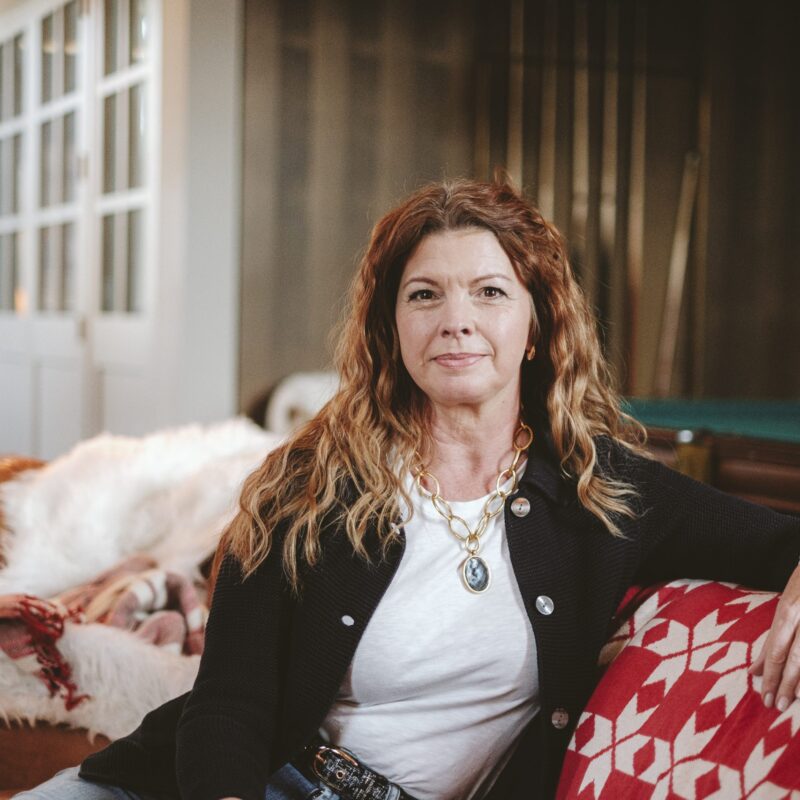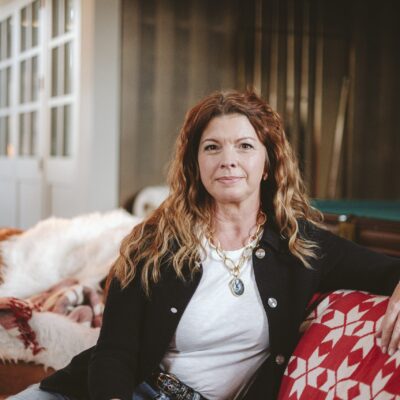 Terry Lilley’s son Isaiah mows the old-fashioned way—more practical in a small lawn space. |
We are living in a new age of green. All things sustainable, carbon-neutral and energy-efficient are hot; locally, new groups are forming to promote the green agenda and institutions like UVA and Albemarle County are making public commitments to sustainable construction. Individual homeowners now have a world of resources at their fingertips, from no-VOC paints to workshops on low-water landscaping. At least one major development, the Belvedere community off Rio Road, is building hundreds of houses to be certified by the green-building program EarthCraft.
Meanwhile, Terry Lilley and Brian Buckley’s escape-artist chicken has been secretly laying eggs behind their rain barrel.
Brian found the eggs recently when he moved the barrel from its spot near the front corner of their Charlottesville house. On a late summer afternoon, he leads Terry and a visitor there to point out the pile of 16 or so white eggs, tucked into the dirt against the foundation. “When the main gardens are in production we keep [the chickens] in the pen,” Terry explains. “In the fall and winter they roam, eat insects and keep pests down.” Though they’re supposed to be contained right now, one of the five birds always gets out and roams the neighborhood (“So far the neighbors are fine with it,” says Terry). “Loosey” is a salvaged chicken—a refugee with a clipped beak who probably escaped from a factory farm before the couple adopted her.
Salvaging chickens is only the beginning of the many green practices in full swing at this “urban homestead.” It’s a homegrown, modest way of life that stands in some contrast to the increasingly slick and PR-friendly green-building movement. Though many of Terry and Brian’s projects could be said to fall under the umbrella of “permaculture”—a system of sustainably designing house and land use which Terry has studied locally—one gets the impression that the couple’s interest in low-impact living goes deeper than any formal movement. Their goal is “to live with less—what we need and can use immediately,” says Brian. It might sound like doing without. But he also says about their life, “There is a sense of bounty.”
A tour of the house on Green Street (how perfect is that?) is a lesson in how much can be done with a hands-on, low-tech approach to shrink a household’s footprint, even if funds are limited. Speaking of limits, Terry and Brian’s property is less than a fifth of an acre. Even in a small space, here’s what they’re up to:
Concrete: 0, Veggies: 1
 Terry, a gardener by profession, grows tons of medicinals and veggies and is working to establish a small orchard—all on a lot that’s less than a fifth of an acre. |
When Terry bought the house in 2004, it had a concrete driveway. Now, in that spot, there’s a lush vegetable garden. “It was the only good full-sun spot” on the property, she explains. Having rented a jackhammer for a basement renovation project, she and Brian put it to work on the driveway. Once they had the concrete broken up and removed, they put down some soil and began planting in 2006: a cover crop of buckwheat to attract pollinating insects and keep the soil moist, sunflowers, beets, onions, tomatoes, parsley and cilantro, among others.
This year, lots of sunflowers have returned as volunteers. Terry says she’s trying to grow as many perennials as possible and let some annuals go to seed, since this will require less work long-term than replanting each year. “Growing as much food as possible for yourself” is a key goal of permaculture, says Brian, not least because it cuts down on fossil-fuel use. Elsewhere on the property are various fruit trees and berry bushes. Between growing food and being a host kitchen for weekly meals of the group Food Not Bombs, Terry and Brian say they only need to buy about 30 percent of their food.
As for the chunks of jackhammered concrete, they’re still here, used to mark edges of beds as though they were stone. (Terry says she’s seen this “stone” called urbanite.) “It’s a remnant of what used to be,” says Brian; it also illustrates another permaculture principle of using what’s already present on-site, rather than acquiring something new.
Salvaged medicinals
Around the front of the house, Terry is converting lawn space to beds for medicinal plants, most of which she’s salvaged from friends and public sites where they were being discarded. The plants are mulched with wood chips from a friend’s trees which were cut by VDOT. Or, says Terry, “You can call any tree company” to ask for waste wood. One plant, comfrey, fills several useful roles: it’s not only a medicinal plant, it provides calcium for the chickens and, when added to the compost pile, speeds up the process of decay.
Playing chicken
Besides controlling insect pests, the chickens also fertilize with their droppings, eat food scraps and, through their scratching and pecking, turn compost piles. And, of course, they lay eggs.
 Come fall, chickens will roam again. |
Their coop is sided with wood salvaged from a local cabinet shop: strips of various wood species, including some premium ones like redwood and mahogany. “It’s kind of heartbreaking when you hear about wood that’s being thrown away,” says Brian. He’s cultivated a relationship with the cabinet shop where both benefit: He has a steady supply of wood, and the shop spends less time dealing with waste. And, of course, it all means less demand for new lumber
This could be useful
 Brian scoops water from a rain barrel. |
“We have so much stuff lying around,” Terry says. On the one hand, successful salvaging is an art of making connections with people who might provide what you’re after. On the other hand, she and Brian are always keeping their eyes open for stuff that could be useful—like when the city cut down some locust trees near the coal tower Downtown, and they took some of the wood. It’s that constant readiness to reclaim that necessitates storage space, so they’ve built a wood shed along one side of their lot. As projects come up, materials are ready at hand.
What is it good for?
A former garage sits at the end of what used to be the driveway. Right now, it’s a shed. But Brian and Terry say they’d rather give the building a designated function instead of letting it collect possessions they might not need. They envision a greenhouse, a workshop and a sleeping loft for guests.
Less lawn
Huge swaths of grass aren’t so green after all, since they need to be mowed. Terry and Brian limit their lawn space and cut the grass they do have with a reel mower, which uses no gas or electricity. When it gets extra long, Terry says, “You might find three of us out here cutting with scissors.” Sounds grueling, but they say it’s a nice excuse to hang out with each other and the two other adults who live in the house.
The lawn is also a place to store bikes (sustainable transportation), hang a clothesline (the pair nixed their dryer and profess a relaxed attitude about clean laundry getting rained on) and arrange furniture—you guessed it, salvaged—into an outdoor sitting area.
Cycling champs
On the furthest part of the lot from the house are the compost piles, where kitchen scraps and garden cuttings are recycled into high-nutrient organic matter that’s like gold to a gardener. Permaculture principles sensibly call for putting anything potentially smelly, like compost, at some distance from one’s dwelling. Same with things that don’t need to be accessed every day—fruit trees, for example. So it’s back here that Terry’s planted raspberries and peaches. Volunteer squash plants have also popped up, their seeds having escaped the compost pile.
One more project located in this zone: humanure. Yep, that’s what you think it is. The ingredients: sawdust, a tumbling device and, well, poop (“harvested” via five-gallon bucket). After two years of tumbling, human waste can be used as fertilizer on non-edible plants, says Brian. This reporter can attest to a complete lack of odor in the vicinity of the humanure operation.
What could be
Besides what’s already here, Terry and Brian have detailed visions of what they’d like to create: a solar-heated outdoor shower, for one thing, and what they see as a safer, more productive use for the space that’s currently an alleyway at the back edge of their lot. People drive too quickly there, they say, and puddles breed mosquitoes. Instead, they’d like to make it a greenspace where kids could play and a pond could harbor frogs to eat the skeeters.
The more the merrier
Terry once dreamed of living off the land in some spacious rural setting. “I’ve been in the homesteading mindset a long time,” she says. Now, she’s adjusting that mindset not only to her small city lot, but to the idea of maximizing the space within her house by including two adults (other than Brian, her son Isaiah and herself) in the household. This saves on energy (five people using one fridge, for example, rather than three or four fridges), helps out with the mortgage and provides more hands for the many manual tasks that a low-impact way of life can demand.
Power down
Speaking of energy, the Green Street homesteaders minimize their electricity bill through some measures you’ve probably heard of—compact fluorescent light bulbs and EnergyStar appliances—and some you may not have, including a solar-powered oven. They also heat their house with a woodstove, which burns (say it with us!) salvaged wood. In helping to dry their clothes when the weather prevents use of the clothesline, the woodstove enacts another permaculture principle: “stacking functions,” or putting everything to work toward more than one purpose. Can your heat pump do that?
The house is light on water use, too. Low-flow showerheads: check. Rain barrels: check. Grey-water system that uses bath water to flush toilets and water plants: check.
Everything old is new again
The granddaddy of Terry and Brian’s salvaging projects is the renovation they’ve completed: turning a storage-only attic into a large bedroom and remodeling their kitchen and dining room. A new stairway leads from the kitchen to the attic; along with the flooring in the new bedroom, it’s made from salvaged wood. Just like the siding on the chicken coop, the walls of the attic are covered in wainscoting made from cabinet-shop “strips.”
 Most of the major materials in the attic renovation were salvaged: wood flooring, railings, and "wainscoting" made from cabinet-shop scraps. |
The couple used paint they scored on freecycle.org, a site where people give away useful stuff. It wasn’t necessarily the no-VOC paint that would earn a construction project points through EarthCraft, but Terry says sometimes avoiding waste is an acceptable tradeoff. “Is it better in the landfill or on the wall?” she asks.
Downstairs, the woodstove and the tile hearth where it sits are also salvaged. How do they find so much good stuff? “Put out there what you need,” says Terry, “and then be patient.”
BREAK IT DOWN
One great, low-tech way to keep waste out of the landfill and make it productive instead is to compost your kitchen and yard scraps. It’s not hard to get started:
1. Choose a spot that’s level, well-drained and accessible to your house.
2. There are plenty of compost devices out there that make it easier to turn and aerate your scraps. Or, you can build a three-sided bin out of concrete blocks, logs or other building materials—or just use the “pile” method, if you don’t mind a less tidy look.
3. Collect kitchen waste including veggie scraps, fruit rinds and cores, eggshells, nut shells, tea bags and coffee grounds. You can also throw in dryer lint, human and pet hair, newspaper, sawdust and wood ashes. Stuff not to compost: meat and dairy products, which will cause problems with smell.
4. Layer the kitchen scraps with “browns” (dried leaves, straw, wood chips) and “greens” (grass clippings and garden waste). Ideally the ratio should be about 25 brown to 1 green. This assures the right mixture of carbon and nitrogen to feed the bacteria that are doing the real work of composting.
5. Add water as needed, keeping the pile about as moist as a wrung-out sponge.
6. Depending on how intensively you manage the compost pile, it will produce nutrient-rich soil in as little as a month—great for adding to your garden.
7. Go deeper into compost knowledge by visiting www.compostguide.com (where we found this information) or reading The Rodale Book of Composting by Grace Gershuny and Deborah L. Martin.
INTELLIGENT DESIGN
This fall, Terry Lilley is coordinating the second local permaculture design course, to be held in October and November at the Rockfish Valley Community Center in Nelson County. The first course, held last spring, filled 35 slots and amassed a 20-person waiting list. Permaculture is obviously drawing local interest. But what is it?
Essentially, it’s a way of sustainably designing and using one’s house and land so that energy use, food production and human relationships are all integrated and working as efficiently as possible—“using design tools based on the intelligence of nature,” says Christine Gyovai, a local permaculture teacher. Practicing permaculture might mean anything from collecting rainwater to building a straw-bale addition on a house.
If you’re intrigued, call Lilley at 296-3963 for more information on the fall permaculture course. Or check out www.permaculture.org.uk for a fuller explanation, a reading list and links to further online resources.





